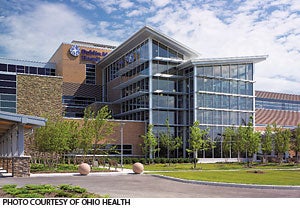Evidence suggests Fable Hospital is the real deal
The Fable Hospital was developed in 2004 by the Center for Health Design's Pebble Project to analyze the impact of implementing evidence-based design in hospitals. Seven years and several hundred research studies later, the clinical and business cases for evidence-based design are stronger than ever.

Dublin Methodist Hospital makes evidence-based design a priority.
That's the conclusion of a recent report written by key persons involved in the Fable Hospital project. The report, titled "Fable Hospital 2.0," was published by The Hastings Center, a nonprofit organization that researches bioethical issues.
Many of the innovations recommended in the Fable Hospital — larger, private patient rooms and bathrooms, more daylight, noise reduction, patient lifts for staff — are becoming mainstream, the report states. The result is fewer patient falls and infections, shorter lengths of stay, and reduced staff injuries and turnover.
Lead author Blair Sadler, a senior fellow at the Institute for Healthcare Improvement and former
26-year CEO at Rady Children's Hospital and Health Center, San Diego, says the increasing demand for quality patient care and outcomes, and expectation of a safe, pleasing environment are driving evidence-based design.
"The overwhelming majority of hospitals being built today are incorporating most of these innovations into their designs," he says. The cost to implement the innovations is about $29 million and the payback is three years.




